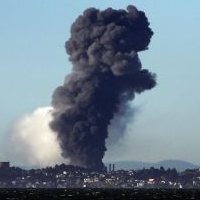Safety Board Says Refinery Fire Was “Close Call” for Neighbors, although Contamination Can’t Be Measured

The U.S. Chemical Safety Board, after reviewing the August 6 Chevron refinery fire in Richmond that sent a cloud of black smoke billowing into the air before spreading out, said the city survived a “close call.”
But it is hard to say how close a call nearby residents survived because monitoring at the site proved wholly inadequate to the task of measuring what toxic gunk made it into the air that people were breathing. The Air Quality Management District, which tracks pollutants like ozone and carbon monoxide on a daily basis, was unable to gather significant data from the fire because its is mostly equiped to just monitor daily ozone and carbon monoxide used to enforce government health standards.
More than 10,000 people streamed into hospitals and clinics after the blaze with an assortment of ailments, including irritated lungs, eyes, ears and noses. And people were warned to stay in their homes and take precautions against breathing the pollutants.
But there were no monitors in place that could give real time readings on what toxic soup they were breathing and it remains doubtful that enough data was gathered to do any postmortems down the road. The air quality district operates 40 monitors in the region, five of which are in western Contra Costa County.
County and air district workers fanned out with eight portable devices for gathering air samples downwind after the fire erupted, but the canisters are considered poor resources for the type of monitoring needed. Chevron employees also were unable to take any meaningful measurements. It will be another week before any analysis is complete from the only authoritative monitor in the area, located two miles away at an air district station in San Pablo.
Technology does exist for doing a better job of monitoring quick releases of pollutants into the atmosphere, but it is expensive. Los Angeles is acknowledged to have far better resources for monitoring than the Bay Area, partially because it has a lot more pollution. The Southland has 11 refineries compared to five up north and around 800 people are employed by the South Coast air quality control district compared to 320 in the Bay Area.
Scientists interviewed by the San Francisco Chronicle say that meaningful monitoring would involve analyzing dozens, if not hundreds, of compounds, an expensive effort that doesn’t have the support of polluters. “We need a better ongoing monitoring system ... in and around the industrial locations. If we're going to understand the impact of the pollution, we need to be more informed,” Mike Jerrett, chairman of environmental health sciences at the UC Berkeley School of Public Health, told the newspaper.
For its part, Chevron says that it is highly cooperative with government regulatory agencies and maintains its own monitoring system. Greg Karras, a senior scientist with Communities for a Better Environment, says that might not be enough.
“The company has resisted giving more resources to locals and to government agencies,” Karras told the Chronicle, “and when they're criticized, they offer to do their own monitoring as an alternative. The trouble is, people don't trust the fox guarding the henhouse.”
–Ken Broder
To Learn More:
Safety Board Says Chevron California Fire “Close Call” (by Erwin Seba, Reuters)
Refinery Smoke Blew Past Air Monitors (by Demian Bulwa and Will Kane, San Francisco Chronicle)
Why L.A. Is Ahead on Gauging Air Quality (by Will Kane, San Francisco Chronicle)
- Top Stories
- Controversies
- Where is the Money Going?
- California and the Nation
- Appointments and Resignations
- Unusual News
- Latest News
- California Forbids U.S. Immigration Agents from Pretending to be Police
- California Lawmakers Urged to Strip “Self-Dealing” Tax Board of Its Duties
- Big Oil’s Grip on California
- Santa Cruz Police See Homeland Security Betrayal in Use of Gang Roundup as Cover for Immigration Raid
- Oil Companies Face Deadline to Stop Polluting California Groundwater





